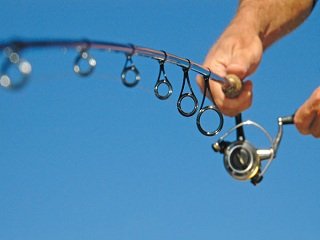In Part One of my series on the three main parts of fishing rods, I shed some light on rod blanks and just what they are and what they do for fishing rods, as far as performance goes. Hopefully, my article helped paint a little clearer picture of what rod blanks are, for those of you who might have otherwise been unaware. Today, my plan is to highlight another important feature of fishing rods: guides.
For those of you who don’t know, line guides are the rings that run along the length of a rod. They guide the line during the cast and retrieve, and the number of them on a rod will depend on the model. Typically, there is one guide for every foot of rod length, but the more rod guides a rod has, the smoother the cast will be. Quality line guides are crucial for accurate, effective casting, and also do a lot when you have a fish on the line. Rod guides can be made up of a variety of different materials, each of which are designed for different purposes, so it’s important to consider your line and target species as well.
Back in the old days, rod guides were made up of steel and polished chrome, which was effective and strong, but very heavy. Nowadays, rods and their inserts are comprised of materials like titanium and silicon carbides, alconite, and aluminum oxide.
Silicon and titanium carbides are among the most popular materials found in rod guides today, due to their lightweight design and durability. They often include ceramic inserts designed to withstand the thinnest braided lines. However, because of their quality, they tend to be found on the more expensive rods. Alconite is another material of which rod guides might be made, and uses a base material of aluminum oxide in the ceramic insert. Guides made of alconite have smoothness and durability comparable to silicon and titanium, but at a fraction of the cost.
Some specific rod models utilize specialized guides that offer different features. Bass Pro Shops’ CarbonLite rods, for example possess guide inserts that are coated with a layer of PVD (Physical Vapor Deposition) for increased smoothness and durability. Other rods, such as some G. Loomis models, implement RECOIL guides, which are made from a nickel titanium alloy that allows them to bend without breaking and return to its original shape and position.
Whichever fishing rod you end up going with, be sure to take a good look at the guides and be sure they can handle what you intend on putting them through. Low-quality guides will not be able to handle braided lines, and heavier guides might be uncomfortable for long days on the water. While guides are a normal feature of fishing rods, they’re often overlooked. It pays, however, to take a closer peek at the guides on your potential rod purchase and see how they match up to your style. Come back for the final part of my Fishing Rod series, where I’ll highlight rod grips.








